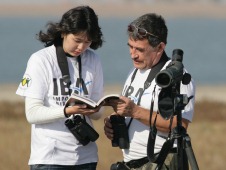
In Central Asia, BirdLife Affiliates are building conservation capacity for the future. A network of student bird clubs established across Kazakhstan and Uzbekistan is helping to fill the gap left when professional conservationists and researchers emigrated after the break-up of the Soviet Union. Participating students receive training in practical conservation skills and contribute to research projects such as those studying the Critically Endangered Sociable Lapwing Vanellus gregarious.
Since 2007, the BirdLife Affiliates the Association for the Conservation of Biodiversity of Kazakhstan (ACBK) and the Uzbekistan Society for the Protection of Birds (UzSPB) have been developing and supporting a network of university student bird clubs across their countries. Training more than 150 members of these clubs in bird identification and monitoring, the principles of conservation, and advocacy and communication, is essential to building a new generation of conservationists in Central Asia.
After the break-up of the Soviet Union, many experienced researchers and conservationists were forced to emigrate in search of employment, which led to an almost complete cessation of research and monitoring in this region. The growing network of student bird clubs has now established an effective and enthusiastic base from which to develop a strategy for conserving Central Asia’s rich natural heritage. The NGOs provide all the necessary equipment, including binoculars, telescopes, cameras, field guides and scientific literature, tents and GPS devices, and organise training, summer camps, conferences and scholarships for study abroad. In turn, the students have the opportunity to assist ACBK and UzSPB in their efforts to conserve birds by participating in conservation and monitoring projects.
Since the establishment of university bird clubs, more than 60 students have been involved in research projects, such as the Sociable Lapwing Vanellus gregarius Project, and the Altyn Dala Conservation Initiative, a large-scale project to protect steppe and semi-desert ecosystems and their key species in Kazakhstan. Three hundred volunteers across both countries provide their observation data to the NGOs. Students have been trained to raise funds and implement their own projects on the ground. The seven clubs in Kazakhstan and five clubs in Uzbekistan regularly monitor ‘their’ IBAs and work with local people, landowners, farmers, and fishing and hunting associations, to develop action plans for the IBAs. They also raise awareness among local communities and school children on the importance of protecting their biodiversity-rich surroundings. The network encourages members to maintain their interest in bird conservation, and it helps to place them in relevant careers. Six former members of Kazakh clubs now work for ACBK, and two members from Uzbekistan are employed by UzSPB.
This case study is taken from ‘Empowering the Grassroots—BirdLife, Participation, and Local Communities’. To learn more about this publication and download the report in full click here.
Related Case Studies in other sections
Related Species
Compiled: 2011 Copyright: 2011
Recommended Citation:
BirdLife International (2011)
In Central Asia a new generation of conservation professionals is emerging from student bird clubs.
Downloaded from https://datazone.birdlife.org/sowb/casestudy/in-central-asia-a-new-generation-of-conservation-professionals-is-emerging-from-student-bird-clubs on 22/12/2024